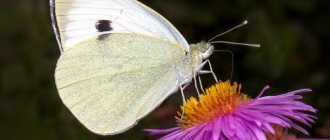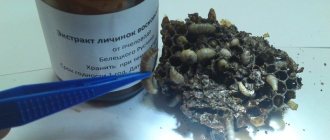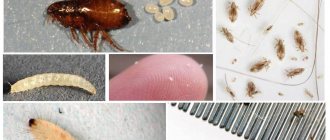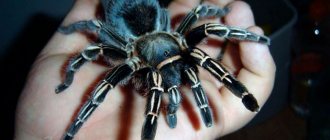Keeping crickets at home
Crickets are grown in two cases - as “singers” and as live food for other pets.
It is quite easy to keep warblers in a container made of any material. The most convenient dimensions are 60x40 cm with a height of 30 cm. The bottom is covered with sawdust. There must be sticks, twigs and any other objects on which insects will climb and where they will hide.
If crickets are grown for food, then you can increase the usable area by filling the container 2/3 with empty cardboard egg boxes. Even sheets of crumpled paper will work as shelters.
Caring for insects consists of:
- maintaining the microclimate in the insectarium,
- cleaning it,
- and feeding pets.
The temperature range for keeping crickets is 28-37 0C. The higher the temperature, the more succulent food should be included in the diet of insects. Daylight should be about 16 hours, so additional lighting is required!
Many insect owners are faced with the question: what do crickets eat in their natural habitat? Let’s find out.
In an insectarium, as in nature, they eat everything - leftover fruits, vegetables, bread crumbs, oatmeal, various whiskeys, dry baby food will do. You can even give sweet corn sticks.
Lettuce leaves, burdock leaves, and tops of garden plants are very suitable as a source of plant fiber. In the summer you can put grass in the insectarium - crickets readily eat it.
Important! To raise sexually mature individuals suitable for reproduction, animal proteins must be present in the diet! Only a plant-based diet will result in the laying of dead eggs. To enrich the diet with proteins, you can use dry gammarus, egg white, fish meal
But you can’t overfeed with such food! This undermines the health of insects, complicates molting, and causes soft chitinous covers
To enrich the diet with proteins, you can use dry gammarus, egg white, and fish meal. But you can’t overfeed with such food! This undermines the health of insects, complicates molting, and causes softness of the chitinous covers.
Types of crickets and creating the necessary conditions for them
The success of cricket breeding depends on how successfully the conditions were created and the maintenance was organized.
Insects must receive enough nutrition and be in an environment close to their natural habitat. In this case, you can expect the crickets to lead an active lifestyle and increase their population. If the conditions are unsuitable, then pets can even kill each other. Ideally suited for home maintenance:
- House crickets are the most common species in captivity. They are small in size and are most often bred for food. With the onset of evening and until morning they can emit ringing trills.
- Banana. The species is characterized by a high reproduction rate and love of warmth.
- Two-spotted. A dry microclimate and relatively low air temperature suit them: 23° C will be quite enough for insects.
The two-spotted cricket is larger than the house cricket: its body can reach 3 cm.
Keeping crickets requires attention to the characteristics of each species. But there are also general recommendations that are universal in any situation.
Over time, a person who keeps crickets at home can draw conclusions and develop his own rules based on experience and observation.
Container
The first step is to take care of the container for growing crickets. Any container made of plastic, glass or chipboard can serve as an insectarium. The main thing is that its area is at least 60x40 cm, and its height is more than 30 cm. In such a space, insects will feel comfortable.
People who know first-hand how to breed crickets at home advise placing boxes with cells intended for eggs on top of each other in the cage. This trick increases the useful area, and the number of pets will increase. In addition, the cells remind crickets of burrows - shelters that they dig in life in the wild. For young individuals that have recently been born, crumpled paper is suitable. Dry fish food mixed with oatmeal, peat, sand, and bran is suitable as a primer. But you don’t have to pour it in.
You need to clean the cage at least once a week. Dirt and waste products of crickets inhibit reproduction and are a substrate for parasitic mites.
To illuminate the container, incandescent lamps with a power of 25 to 40 W are used. They will not only create light, but also be a source of heat. A 16-hour daylight period is sufficient for crickets to thrive.
Microclimate
The microclimate suitable for crickets consists of two important indicators:
- The optimal temperature depends on the species. For example, the heat-loving banana cricket does well when it is above 26°C, although it would prefer a reading between 28°C and 37°C. For house and two-spotted crickets, a temperature of 23 °C is suitable. The higher the air temperature, the better the health of chirping pets and the more intensive their growth. But at the same time they need more food and more frequent bedding changes.
- Air humidity should be at least 40–50%. This value is especially important for cricket eggs, which can simply die in dry soil. Therefore, the substrate with masonry must be constantly moistened. If the humidity is too high, then mites will appear in the insectarium, and this will mean the possible death of the crickets.
Once suitable conditions have been created, the first residents can be allowed into the container.
Cricket breeding
Each cricket’s territory is home to several females, who come to its burrow attracted by its song. A courtship dance and mating takes place, a few days after which the female lays eggs. They have a long ovipositor; the female uses it to pierce the soil to lay eggs there.
Lays 50-150 eggs per season. But if the conditions are favorable, the air temperature is about 30Cº, then the female lays up to 700 eggs. The eggs are white and shaped like a banana. House crickets can lay one egg at a time or in groups in different crevices.
Then, depending on the temperature, after 1-12 weeks, larvae - nymphs - are born. These larvae will go through 9-11 stages of development. At first, young individuals try to stay together, hiding from enemies under stones and in earthen burrows. After the third molt, the crickets become older and spread around the area in order to dig their own burrows. When cold weather sets in, the mink is made deeper to survive the winter.
Usually the temperature underground is not lower than +0Cº, and if minus happens, the cricket goes into hibernation. With the onset of warm May days, the insects come out and molt for the last time. After molting, they look very funny, with their white wings not straightened and not dried out. Adults live for about 1.5 months. Tropical species live 6-7 months.
In the summer, when day turns into evening, a characteristic chirping sound begins to be heard in the grass. This sound cannot be confused with anything else; it can only be produced by one insect - the cricket.
In warm weather, they live in nature and eat what they find, mainly plant foods. But in addition to plants, they happily eat small representatives of the class of invertebrates, which, unfortunately, come across in the path of crickets.
Also, crickets do not shy away from carrion. Like many insects, crickets exhibit cannibalism.
Mostly adults eat their fellows; they not only destroy young animals, but also devour clutches.
Crickets love the warm season; they cannot tolerate even a little cold. In cold weather, these insects often crawl into residential or industrial premises that are heated for the winter. Therefore, in the house in winter you can hear the singing of this insect.
Living in close proximity to people, this “bakery singer” (that’s what they were called because they used to live behind stoves) has no problems with food. Almost anything suits him: waste from fruits and vegetables, bread crumbs, that is, any small pieces of food.
Crickets have a particular preference for a variety of liquids. Those owners who have food left on the table have a real paradise for crickets. Warm air and a large amount of food are favorable conditions for the life of crickets.
Unfortunately, these baked musicians are becoming less and less common in homes today. Crickets, unlike cockroaches, avoid concrete multi-story buildings because it is impossible to dig a hole for shelter there. Therefore, you can only hear a cricket in a private house. But how long will this situation continue? Maybe soon there will be no more of them left in city houses.
In the old days, not all insects were valued, but individual insects were considered the true guardians of the hearth, a favorable sign for the future. Of course, the cricket, whose song personified peace and family well-being, also fell into the “pet” category.
Cricket nutrition
Crickets feed on different “products”, depending on their habitat. In nature, they eat plant foods, and if they live near a person, they feed on leftovers from his table.
Especially liquids. In addition, the house cricket can eat invertebrates, corpse tissue and can be classified as cannibals - adult individuals can eat clutches and young larvae.
Sometimes crickets are specially raised at home, for the sake of their songs or as food for certain types of animals (amphibians, and other reptiles, as well as birds). Then they are fed with leftover fruits, vegetables, cat food, dry baby food, oatmeal, bread crumbs, and corn sticks.
Be sure to give plant food: burdock leaves, lettuce and tops of garden plants. Crickets also need protein, which they can get from fish meal and egg white. But such food should be given in moderation; insects should not be overfed, otherwise their chitinous coverings may become limp and molting will become more difficult.
Carrots, apples, cabbage are given grated on a coarse grater, little by little. Water is also necessary for insects, and if you breed crickets, you need to provide them with liquid. It is better not to place the drinking bowl in the insectarium, but to put a sponge soaked in water there. One of the large insectariums is located on the territory of the Moscow Zoo, where crickets are bred to feed various animals.
Feeding the crickets
In the wild, the cricket feeds on pieces of plants, small insects, and dead arthropods. Some individuals do not disdain cannibalism and destruction of the clutches of their relatives. But what to feed crickets at home?
When kept in captivity, the following is suitable food for crickets:
- finely chopped vegetables and fruits;
- greens, tops, burdock and dandelion leaves;
- milk in powder form, including infant formula;
- oatmeal and bran;
- food for cats and dogs;
- boiled chicken egg;
- boiled lean meat.
A very important component of a cricket's diet is protein. If there is not enough of it, the insects will begin to eat each other. Females that feed only on plant foods lay eggs that will soon die. And the life expectancy of adults will be much shorter. Therefore, it is necessary to add fishmeal, egg whites and gammarus, which is used to feed aquarium fish.
How to water crickets? Some experts suggest installing a drinking bowl, but this is not entirely safe: young individuals drown in them, females lay eggs, and it’s quite easy to turn it over. Another option - spraying one corner with a spray bottle - entails a persistent increase in humidity, and, as a result, the appearance of mites. Therefore, to save yourself from problems, you just need to give enough juicy and wet food, forgetting about drinking bowls and spraying. But we should not forget: lack of moisture will lead to death or cannibalism.
Features of keeping crickets
Container
Option for arranging a container for crickets
If you decide to have such an original and noisy pet in your home (crickets make characteristic sounds, so immediately ask yourself if you are ready for this), make sure to purchase a fairly spacious container. Its size will depend on the number of pets and how comfortable conditions you are going to create for them. You can keep a whole thousand crickets in a container 450 by 425 and 500 centimeters, or even several. The difference will be in the level of comfort.
If the walls of the container are high, you don’t have to cover it, however, in order to avoid all sorts of troubles associated with finding a cricket under the bed or in the bathroom, it is better to take care of a special mesh lid.
The walls of the container should be smooth - it can be glass or plastic. This is necessary in order to prevent the pet from escaping vertically. Do not forget that crickets move very well and quickly on flat vertical surfaces.
If you are going to keep a cricket in a wooden box, then it is better to cover its inside walls with thin glass so that it is not so easy for the cricket to climb up them.
House
Even if you have taken care of a spacious container, do not forget about a special house. You can use egg cartons for this. Place it vertically with small pieces of cardboard between the sides. This will prevent the egg combs from sticking together and there will be good ventilation in the house. Crickets love to hide in such houses.
Substrate selection
At the bottom of the container you will need to pour... not substrate, but dry food. It could be oatmeal, dry baby food, gammarus... Some people add dry food for cats or dogs. True, there is a lot of debate regarding the usefulness of the latter, whether it is worth doing this. So, it's up to you to decide. You will need to place a feeder on top of the food layer. Its role can be played by a board or plywood - on it you will put a portion of wet food every day - carrot salad with apple, lettuce, burdocks, dandelions...
By the way, its appearance depends on the cricket’s diet. The more varied its diet, the more beautiful the cricket looks.
Temperature regime for keeping crickets
Egg tray houses
Crickets are heat-loving creatures and keeping them in a container where the temperature is below +26 degrees is not recommended. If the temperature column of the thermometer shows lower numbers, take care of artificially heating the air using a spot heating lamp.
In addition, additional ultraviolet light will promote the synthesis of vitamin D3 in crickets, which is also good for them.
Reproduction
Breeding crickets as a business is quite a convenient way to make money. Indeed, in captivity, when optimal conditions are created, these insects grow very well and quickly, reproduce and actively increase the population size. For best results, a male to female ratio of 1:4 or even higher should be maintained. This is the only way to avoid constant loud noises at night, aggression, and cannibalism.
If you place a cardboard egg tray at the bottom of the container and pour a little earth, peat, sand into it, then these places will be intuitively chosen by females for laying eggs. And to prevent the destruction and destruction of the larvae by adults, you can lay a thin mesh on top.
“Where should we sell them, in the passage?”
While the oven warms up to 170 degrees, Sergei shares the intricacies of doing business in Belarus:
— Initially we took 16 thousand dollars. Our team consisted of three people: me, manager and breeding specialist Andrey, as well as our financial partner. Of course, the original plans differed from the outcome. I imagined that everything would be like in Russian companies: work with pet stores, beautiful packaging, barcodes, everything is official. As a result, it turned out that this was not in our budget at all. We built a farm, put up shelving, and that's when we ran out of money. What to do? They told us: “Sell crickets.” Okay, but where to implement it, in the transition?
And then we were faced with moving from one farm to another, after which winter came and the crickets froze. It cost us a pretty penny - we ended up spending 26 thousand dollars. Even when you lose 70% of your cricket and it takes 2-3 months to restore it, you still have to pay rent, salaries to your employees, taxes.
What to feed house crickets
You can feed crickets with a variety of vegetable crops and herbaceous plants. Carrots, beets, lettuce, and clover heads are perfect. It is also very advisable to add pork or chicken feed to the diet. It is worth feeding not in large portions, but often - at least several times a day.
- Since ancient times, crickets have been especially revered in China and Japan, in these countries they even organized special competitions for singing domestic crickets, and the rich people there were ready to give entire fortunes for the winners.
- Since ancient times, it was believed that having a cricket in the house brings good luck, prosperity, and well-being.
- According to recent research by scientists, the trills of crickets have a beneficial, calming effect on the human psyche. Only the purring of a domestic animal has a similar positive effect on a person.
What to feed the larvae
Zophobas larvae: on the left - just molted, still white
Typically, the larvae are fed potatoes, apples or carrots - this is cheap and always available, and this food also provides the larvae with the necessary water. It is also common to keep them on bran or oatmeal - these products serve not only as food, but also as a substrate, in which the larvae can burrow and feel safe. Just in case, we note that for other animals (cockroaches, crickets, etc.) this method should absolutely not be used; darkling beetle larvae are the only ones that can be kept on the food substrate. Both larvae and adult beetles can consume protein sources such as dog or cat food and even dead fish, leaving behind only tough skin and bones. Does not cope well with pure fats or very fatty foods such as avocados.
How often to clean the cricket container
To prevent bacteria and germs from multiplying in the container, it is recommended to clean your pet’s house at least 1-2 times a week. During this time, he should be placed in a temporary house. But if you notice that its abdomen is swollen, and an unpleasant odor emanates from the container itself, you should not limit yourself to cleaning alone. Your pet could become infected with microsporidia and you will need to disinfect its home.
Unsanitary conditions for keeping crickets encourage the development of mites, and this can lead to the death of your unusual creature. Therefore, do not ignore cleaning, and if you have already got a cricket, keep it not only comfortable, but also clean.
About project cost and profitability
Recently, my investor and I completed a business plan and studied sales markets.
Costs and payback. It turned out that the threshold for entering this market with all costs (purchase of necessary equipment, renting premises, purchasing inventory, repairs, etc.) is no more than $25,000, and the payback period (even if you divide the profit figures by two) is not more than a year. Even according to minimal estimates, the farm's income is about $100,000 per year. This already takes into account the minimum fixed prices for products, inflated prices for the implementation of the project and the purchase of everything necessary.
Our cost is very low. One kilogram of cricket, with all costs, costs no more than $2.
After monitoring the world market, according to preliminary estimates, we will be able to set the following prices for our products:
- Frozen crickets for food - at least $20
- In flour - now a 120 g bag. costs $10 (based on ebay). But, of course, we will do it cheaper - for popularization
One kilogram of cricket flour is no more than 8000 pieces. This means that in one box (crickets are kept in special boxes) about 2-3 kg of flour grows. There will be about 200 such boxes at launch.
Sales markets. The main thing for us is the sales market. But there are no problems with him. As long as we are given permission to start the food industry, we will sell crickets for feed, and the Russians will even take such a small volume, 800-1000 kg per month at $20 per kg, from us in bulk. The demand is real, we studied it. And there is also the Ukrainian market, where our products are also in demand. And our poultry farmers, hedgehog keepers and other lovers of exotic animals are now ordering frozen food from Russia.
Photo: Daria Buryakina, TUT.BY
In China, 27,000 tons of dried cockroaches are required per year for pharmacology and cosmetics production. Of these, only 21,000 tons are provided in full. One pound (about 0.5 kg) of dry cockroaches costs around $89 - a very good income. So you can open a cockroach farm right in China. This is also real - my companion studied the topic.
We already have a specific proposal from Canada: to build a farm there, organize work and train a management team. And we are seriously discussing this.
The legislation is much simpler for them; there are no barriers. They are now raising private businesses. The most expensive thing there are salaries, but if you consider that a farm of 250 m² requires only 3 workers, and the output is a ton of crickets per month, then this arrangement is quite suitable for them. There is only one difficulty there. There are cricket farms, but they only produce crickets for fishing and food. And the guys who contacted us want to breed them for food. And these are different conditions of detention and feeding. We know this and can implement it. I’m afraid that it will really turn out that our farm will appear in Canada earlier than in Belarus.
During this year, more than 49 farms were built in the world. And that's just crickets. So we are at the forefront.
And now the main thing is that we do not sit out this peak while waiting for our legislators. In Russia, too, legislation in this area has not yet been finalized; there are no sanitary requirements. But there are already farms there (albeit illegal ones) that employ 40 people - you can imagine the volume there.
Once we push through legislation, we will have very little time to fill the market. I think the country will be hit by a wave of legal insect farms.
Because it is many times more profitable and environmentally friendly than raising cows, pigs and chickens.
What are they eating?
Their diet is varied. But mainly it consists of the food described below.
Dead insects. If they find dead insects, they will eat them. The less intense the prey hunt, the better for crickets.
Mushrooms. Since they spend a lot of time around wooden piles and in damp conditions, they encounter fungi. Why not eat them, because they are motionless and you don’t need to waste energy on hunting?
Plants. Leaves, stems and seeds are good food for these insects.
Fruits. This applies to fruit that has fallen from a tree or is in your home. If they have access to something sweet and soft, then they will like it.
Cloth. Yes, they even eat clothes. If you leave it on the floor in your home or outside for a certain period of time, you may notice the damage caused. They don't care when they're hungry. They will eat silk and even wool.
Other crickets. If there is no food around, they will begin to hunt for cannibalism.
Paper. They eat paper products. Naturally, if there is nothing tastier nearby.
Leather. They also eat leather products. They will chew on leather sofas, wallets, bags, etc. Therefore, if such “guests” appear in your house, it is better to hide any leather items.
My team
At the same time, I was looking for a team. I decided on an investor (after all, he was the person who “asked a lot of questions”). There was also a partner ready to start selling. But I understood that to create a full-fledged farm, I needed specialists in a specific field. I contacted the guy I bought my first crickets from. It turned out that he had been doing them for more than 15 years. And for the last 10 years he has been breeding exotic animals and spiders. The question regarding the candidacy of a technologist was removed. I don’t need a novice scientist who only knows from books what and how - I needed a specialist who has practical experience and understands the topic.
For example, with the help of my work and that of Andrey (technologist), we were able to develop our own “secret” compound feed for crickets. And this is a very important point. Crickets are polyphagous: they eat both insects and plant foods. And the lack of a protein component gives rise to cannibalism - it is very unprofitable for us for them to eat each other. We solved this issue with the help of compound feed that contains protein. And also secret ingredients, without which mass breeding of crickets is hardly possible.
It's like Coca-Cola - no one knows the recipe. Until ours is “deciphered”, we have some time to spare in case of an invasion of people who want to open similar farms - and I’m sure this will happen.
So, I have a team: me, an investor, a sales specialist and a technologist. And this is the best team I could ever imagine. The technologist immediately began to develop conditions for the mass keeping of crickets and other inhabitants of the farm (and we plan to breed also zofobas beetles and mealworms). I started working on a business plan and, together with the investor, we began to push through legislation.
We immediately decided that all team members would have a share in the business - in my opinion, this is the best motivation. And the main thing that unites us all: we all want not just to open a farm, but to create a brand called Crickets.by. By the way, I completely wrote the site a year ago and made it myself. While it is purely informative, I will popularize the topic through it.
Photo from the personal archive of Sergei Makarov
Legends and beliefs about crickets
So, the cricket family belongs to the order Orthoptera, and in nature there are about 2,300 species. These insects consider a moderate humid climate to be a favorable habitat, and their historical homeland is the island of Madagascar and India. However, today these night “singers” are widespread throughout the world; moreover, numerous legends and beliefs are often associated with them.
Many crickets fly into the house and settle in secluded places, and some species are considered exotic and turn into real human pets. This is not surprising, because there is an opinion that such insects appear only in those homes where there is a feeling of kindness, comfort and coziness. So this is a positive symbol for the future, and you should not kick the cricket out of your abode.
The domestic cricket gets along well in the same territory with humans, does not cause any difficulties and, moreover, does not harm in its own habitat. He only sings, and there is no doubt that he is the strongest male of all competitors. Females prefer to remain silent in the presence of the leader, and weak males are simply expelled from the home. So it’s the same melody, which very soon becomes familiar and even positive.
Interesting facts about crickets
- There are 3,700 species of crickets, of which only 30 can live in Russia in our climate zone, and only a few can live in houses.
- Previously, competitions were held for singing house crickets. The Japanese and Chinese were generous and never spared money for these individuals.
- The homeland of house crickets is North Africa and the Far East. They were transported to America from Europe.
- Crickets come out to forage for food or just take a walk at night. When they leave their “house”, the entrance to it is blocked with grass.
- As it turned out, crickets can be consumed as a delicacy, as Asians do. Cricket fishing is common in North American countries.
Insect nutrition
In their natural environment, crickets feed on fresh grass shoots and bush leaves. Having settled on the site and significantly increased the population, they will begin to harm garden crops. Adults prefer to nibble on seedlings rather than weeds. Their diet is not limited to plant foods; insects require protein for development. Its source is small insects, corpses or their own offspring.
What does a cricket eat when it finds itself at home? In this case, he shows omnivorousness, eating crumbs of bread, droplets of liquid dishes and drinks, pieces of vegetables and fruits with equal pleasure. Meat or fish that falls on the floor will also be eaten by the little neighbors. Showing the instincts of a hunter, they can catch flies or small invertebrates that end up in the house.
Many seemingly harmless insects turn out to be a source of danger, so the question often arises: do crickets bite? You can rest assured about night singers, they don’t bite people. The jaws of the gnawing type are not adapted for attacking large objects; moreover, aggressiveness is shown only towards males in foreign territory.
What does the house cricket (house cricket) eat?
Under natural conditions, the basis of the menu of house crickets is any plant food. However, insects require protein supplements in their diet. They satisfy this need by attacking small invertebrates, eating dead insects of other species, or even attacking their own kind. Quite often, young individuals of crickets become an additional dish for an adult relative, and eating egg clutches is common.
Once in human homes, crickets gain access to a limitless source of food. House crickets enjoy eating pieces of vegetables, fruits or bread crumbs left after breakfast, lunch or dinner. If a cockroach or other small insect gets in the way of a house cricket, it will certainly become part of its diet. No less attractive to crickets are droplets of any drinks consumed by humans, with the exception, of course, of alcohol.
House cricket (house cricket) - description, appearance, characteristics.
House crickets are fairly small insects. The size of the slender, slightly flattened body, covered with a hard chitinous shell, in adult individuals ranges from 16 to 26 mm in length. The color of the domestic cricket can be grayish-yellow, straw-fawn or various shades of brown with streaks, specks or spots of indeterminate shape.
On the head of the cricket, which resembles a flattened egg in shape, 3 dark arcuate stripes are clearly visible. The small eyes located on its sides have a complex facet structure. The mouthparts of crickets are of the gnawing type in structure. The antennae, consisting of several segments, are an organ of touch. Often their size is slightly greater than the length of the cricket's body.
The rear pair of well-developed membranous wings helps house crickets easily fly from place to place. At rest, the cricket's wings lie along the abdomen and resemble long, sharp tails. If necessary, house crickets can travel quite long distances. When the insect is on the ground, its wings are reliably protected from damage by dense elytra that lie flat on the back, with the right one slightly overlapping the left.
Like all orthoptera, the house cricket has 3 pairs of legs. The hind legs have thickened thighs and are designed to perform fairly long jumps. It is noteworthy that the hearing organs of these insects are located on the shins of the front pair of legs. The paired appendages located on the last segment of the abdomen are quite long and resemble peculiar antennae sticking out in different directions.
Sexual dimorphism is expressed in the presence of a special sound apparatus in male crickets, which is similar in structure to the sound apparatus, but differs from it in greater complexity and a different arrangement of components. The stridulatory vein, which functions as a closure, is located on the right elytra, and the vein against which it rubs is located on the left elytra. When they rub against each other, the familiar trill of a cricket appears. In crickets, the sound apparatus is more developed and occupies a larger area than in grasshoppers.
Female crickets have an ovipositor at the very end of their abdomen, shaped like a spear. Its length ranges from 11 to 15 mm. With the help of this organ, females dig holes in the soil into which fertilized eggs are laid.
The average lifespan of a house cricket rarely exceeds 3 months.
Breeding crickets
Crickets can also be bred at home - important for those who consider them as food. The main thing is to create the right and comfortable living conditions for them, and to have a small colony where there will be males and females. There should be more females than males. For 1 male there are 4-5 females. Otherwise, you will witness crickets fighting and they will sing very loudly. So that your neighbors will definitely ring your doorbell.
A small container 4-5 centimeters deep filled with a damp substrate is placed in a container with adult crickets - this time the substrate is earth, sand, or peat. It could even be wet food. Female crickets are not very fussy when laying eggs.
It is better to cover the top of the container with a fine mesh with cells, so that later, when the female lays eggs, adult crickets will not eat them.
Female crickets lay eggs in portions of 2-5 pieces. One clutch can contain from 350 to 900 eggs. So your population will increase rapidly. Depending on the temperature conditions, after 1-2 weeks, cricket dust will appear - babies 1-2 millimeters in size. Over the course of several months, they will grow and molt until they reach sexual maturity. Then they will be ready to reproduce.
In the summer, when day turns into evening, a characteristic chirping sound begins to be heard in the grass. This sound cannot be confused with anything else; it can only be produced by one insect - the cricket.
In warm weather, they live in nature and eat what they find, mainly plant foods. But in addition to plants, they happily eat small representatives of the class of invertebrates, which, unfortunately, come across in the path of crickets.
Also, crickets do not shy away from carrion. Like many insects, crickets exhibit cannibalism.
Mostly adults eat their fellows; they not only destroy young animals, but also devour clutches.
Crickets love the warm season; they cannot tolerate even a little cold. In cold weather, these insects often crawl into residential or industrial premises that are heated for the winter. Therefore, in the house in winter you can hear the singing of this insect.
Living in close proximity to people, this “bakery singer” (that’s what they were called because they used to live behind stoves) has no problems with food. Almost anything suits him: waste from fruits and vegetables, bread crumbs, that is, any small pieces of food.
Crickets have a particular preference for a variety of liquids. Those owners who have food left on the table have a real paradise for crickets. Warm air and a large amount of food are favorable conditions for the life of crickets.
Unfortunately, these baked musicians are becoming less and less common in homes today. Crickets, unlike cockroaches, avoid concrete multi-story buildings because it is impossible to dig a hole for shelter there. Therefore, you can only hear a cricket in a private house. But how long will this situation continue? Maybe soon there will be no more of them left in city houses.
Banana Cricket Breeding
August 17, 2013 admin
Banana cricket (Gryllus assimilis) is the most common food among exotic lovers. It is eaten with pleasure by all animals that feed on insects: turtles, lizards, amphibians, birds. The banana cricket is native to Jamaica, and from there it was distributed throughout almost all of Central America.
What is the difference between banana crickets and brownies? In size, this is a fairly large insect. Adult banana crickets are 18-25 mm long, with the length of the ovipositor in females being 12-16 mm, while brownies are 16-20 mm long, and the length of the ovipositor in females is 11-15 mm. They are able to reproduce all year round, and under favorable conditions they reach sexual maturity within a month. And if necessary, you can accelerate or slow down the development of larvae only by adjusting the temperature regime.
Breeding banana crickets is not a labor-intensive process; these orthoptera insects eat plant foods, small invertebrates, and the corpses of their fellow creatures, and if there is a lack of food, they can devour each other: laying eggs, young animals. Here is another characteristic difference from the house cricket - cannibalism.
To breed banana crickets, tall plastic or glass containers, aquariums, or any plastic containers for food products are used, or, in extreme cases, wooden boxes, but they are more difficult to handle and wash. All containers must have tight-fitting lids, but with holes for air to enter. Usually this is a soldered fine mesh (2-4mm). Ventilation hole size: almost the entire surface area of the lid, with the exception of the perimeter edges where the mesh is attached. To prevent the crickets from crawling out of the cages, coat the upper edges, approximately 15 cm, with Vaseline; in wooden boxes, you can glue foil or glass.
Wingless crickets do not climb on a slippery, smooth surface, therefore, in solid glass and smooth plastic high (more than 40 cm) cages, crickets can be kept without lids. The height of the cage must be sufficient to install shelters. Typically, egg cartons stacked on top of each other are used for these purposes. With this content, you can save on the substrate, and only newsprint can be laid on the bottom. But if peat is used as a substrate, then it must be changed regularly (once a week). To constantly update the crickets, it is advisable to have several such cages.
What to feed banana crickets? Both dry and succulent food are suitable for feeding banana crickets. Namely, always available bran, cheap oat flakes, dry, crushed bread, dry fish food (daphnia, gammarus, etc.), mixed feed, egg defect. You can add powdered milk, baby milk cereals and mixtures to your diet. From succulent food - vegetables and herbs: grated carrots, Jerusalem artichoke, rutabaga, turnips, any cabbage; from fruits: apples, pears; lettuce leaves, cereal herbs and flower buds.
Sometimes try to diversify your diet with pieces of fish or meat, but do not leave them for long to avoid infection. Adult banana crickets need water, but it is not necessary to install drinking bowls; it is enough to periodically spray the walls of the cage with a spray bottle once every 2 days, but be careful not to flood the cage. High humidity is harmful to crickets.
To stabilize growth, stimulate development, and also improve the nutritional value of crickets, UV lamps with UVB 4-5% can be installed above the cages.
How many banana crickets do you need to breed? Based on the calculation of 4-5 adult individuals per 10 sq.cm, or 1 male per 3-4 females. The most comfortable temperature when breeding banana crickets: 28-32°C, at least 26°C. A sexually mature female is capable of laying up to 500 eggs during the period of her life (two to four weeks). Egg development takes 7-14 days. Crickets grow within 1-1.5 months, molting periodically.
In order for the female to lay eggs, prepare the cages by filling them to the brim with any moist substrate: coconut with vermiculite, peat with sand, vermiculite, loose soil with vermiculite. Place a plastic or iron fine mesh (3-5 mm) on the ground; it will not interfere with egg laying, but will protect it from being dug up and eaten by neighbors. After a week, transfer the cage to another container with a constant temperature of 30-32°C, where a new generation of insects will appear.
breeding crickets at home.
| Organization of the queen cell of crickets |
| Good afternoon, dear subscribers and guests of my channel! In one of the recent videos published on my… |
| Tags: |
| How to breed and keep crickets |
| I'M ONLINE: vk - instagram c1 - inst2 - https://www ... |
| Tags: |
| Breeding and keeping crickets |
| Have you bought crickets for your frog and don’t know how to care for them? You don’t want to drive them around every three days… |
| Tags: |
| Keeping crickets for feeding. |
| Female house crickets lay their eggs in a container with damp sphagnum moss. You may also find it useful... |
| Tags: |
| Breeding crickets. Part 1. Females lay eggs |
| Breeding crickets at home is an interesting start-up. Cricket is exotic, and reconnaissance... |
| Tags: |
| Breeding Crickets at home as a business idea |
| WE PROTECT ANIMALS AND THEIR OWNERS -... |
| Tags: |
| CRICKET BREEDING / REPTILE FEEDING. |
| Keeping and breeding crickets at home. |
| Tags: |
| CRICKETS! KEEPING CRICKETS AT HOME! LIVE FOOD FOR REPTILES! |
| Reproduction of food crickets in containers. |
| Tags: |
| Reproduction of the food cricket. |
| Guys, in this video we will tell you how to keep crickets at home!) As you may have noticed... |
| Tags: |
| Breeding house crickets |
| Have you decided to freeze crickets for long-term storage, but don’t know how to package them in bags? .. |
| Tags: |
| KEEPING CRICKETS / LIVE FOOD FOR REPTILES AT HOME / PART 1 HOUSE CRICKET |
| Good afternoon, dear subscribers and guests of my channel! While studying topics on growing crickets,… |
| Tags: |
| How to replant crickets |
| #cricket. |
| Tags: |
| Keeping crickets. |
| - feeding the fish. |
| Tags: |
| Cleaning containers with small crickets |
| MAIN CHANNEL: ▻▻▻ ELITE CHANNEL: ▻MY PUBLIC: … |
| Tags: |
| About crickets |
| For the first time I decided to breed crickets for our leopard gecko. It turned out that it’s not difficult)))) You may also… |
| Tags: |
| Keeping young crickets. Mini farm for breeding zoophobass |
| Keeping crickets at home. |
| Tags: |
| THE CRICKETS ARE DYING TOO FAST!” rel=»spf-prefetch |
| Description missing |
| Tags: |
| Keeping baby crickets" rel="spf-prefetch |
| Description missing |
| Tags: |
| Breeding of forage crickets. Part 3." rel=»spf-prefetch |
| Description missing |
| Tags: |
| Crickets: care and breeding" rel="spf-prefetch |
Financial part
The project for growing crickets is also interesting in the sense that it is quite profitable and simple. A beginner will not have to invest large sums of money to set up a farm. The purchase of equipment is not required, and 1-2 people are sufficient. The cost of the product is very low and fluctuates around $2 per 1 kg of weight.
The profitability of the project is considered high, since even at the lowest prices, you can receive up to 100 thousand dollars per year from a small farm. And the purchase of inventory, containers and other unforeseen expenses will cost no more than 25,000. That is, already from the first batches of sold products in any form, you can return the investment.
Video: how to breed and keep crickets?
Nutritional Features
Today, modern man has been able to tame even such a small insect as a cricket. The purpose of his breeding was melodic tunes, which he produces with particular regularity. In order to raise a full-fledged individual at home and count on offspring, you need to know the rules of nutrition and tirelessly follow the recommendations below.
So, crickets are omnivores, so it is quite acceptable to experiment with the menu, adding or removing new dishes each time. Leftover fruit is considered a favorite delicacy, and you can give food that is not the freshest. Crickets will definitely be grateful for such vitamins, especially since they are not particularly selective in their food consumption.
In addition, you can pamper the insect with oatmeal and crackers, which they will happily eat. Any crumbs will be welcome, and the cricket doesn’t need much to feel full and start singing its catchy trill again. The diet may also contain coarse fiber in the form of a bunch of dry grass to normalize intestinal function.
So it is important to observe all these subtleties and not deviate from the diet suggested above
If you decide to grow crickets at home, you can use an old aquarium as a house, with an even layer of soil and substrate placed on the bottom. The presence of branches and dry grass is also necessary, otherwise the trill of the insect will not be heard.
Soft caterpillars and pupae can also make up the cricket's daily menu, but it is advisable to offer such ingredients in strictly limited quantities for the normal functionality of the digestive system. Insects also love leaves of all plants, dandelions, unripe grass seeds and clover leaves.
If it is crickets that are bred at home, then the adults feed well from the feeder, while it is advisable for the young to distribute food over the entire surface of the soil
Over time and as individuals grow older, the need for this disappears, but at first it is important to control so that the inexperienced insect does not starve
Now on the free market, special plant-based foods predominate, which provide a full range of minerals, vitamins and microelements
The presence of protein as the main organic compound is very important, since a deficiency of this element leads to the non-viability of laid eggs. Moreover, the female quickly eats them, so it is best to use boiled chicken protein in the diet
Many crickets, accustomed to living at home, eat synthetic food from fish, dogs and cats, and such an unusual diet in no way affects their viability or reproductive function. Milk can be offered as a drink, but this is at the choice of the breeder himself.
Cricket lifestyle
All crickets require warmth to live. They rarely settle in apartments, since in the spring and autumn the heating is turned off, and the apartment becomes cold for these insects. Therefore, they prefer to choose their home in stores, at heating units, in bakeries, and boiler rooms.
It is almost impossible to see a cricket during the day, since its activity occurs at night. During daylight hours, they sit in crevices and secluded dark corners, and only at night can they be detected by sound.
There is a sign that if a cricket appears at home, it is good
Adult males control their territory, making daily rounds and checking it for the presence of rivals. If a stranger gets in the way, the crickets will inevitably fight. During a fight, they try to bite off each other's paws and antennae, and hit their thick heads. The winner may even eat the loser.
This spectacle is quite exciting to watch, so in some countries they even organize cricket fights. They have developed a special diet for fighting insects, cold medicines, and provide them with meetings with females to maintain morale.
Features of cricket
The main feature of this insect is its ability to chirp. Only males who use their vocal abilities in the interests of procreation are capable of this.
The familiar sound of a cricket is a kind of “serenade” for the female
First, the cricket lures the female, indicating its readiness to mate. Then he sings serenades to her, this is the period of courtship. Well, with the third type of signal, male crickets drive away competitors.
The sound is produced by rubbing the teeth of one elytra against the chirping cord of the other. The elytra rise and by their trembling form sharp vibrating movements, which are the source of sound.
Externally, crickets are similar to, but larger. The largest species living in our country is the field cricket, 2-2.6 cm in size, black with orange spots on the elytra and orange thighs.
The entire body of the insect is covered with a chitinous shell, which protects it from damage and reduces moisture loss. There are domestic, field and tree crickets, which differ in appearance. But everyone's songs are equally good.
Feeding frequency
Dry food should be present to insectaries at all times.
To avoid rotting, it is better to give succulent food (carrots, apples, cabbage, rutabaga) 1-2 times a day, after grating it on a coarse grater. A small portion, placed on a bowl, is left in the insectarium for an hour to an hour and a half, and then removed. At the next feeding, a new batch of grated feed is prepared. The same goes for pieces of meat.
Recommendation: water should always be freely available to insects. However, you should not put a drinking bowl in the insectarium - young crickets can drown in it. It is much more convenient to use a foam sponge soaked in water. You need to make sure it doesn't dry out!
Cricket Reproduction
Crickets have polygamous relationships, each male is the owner of a certain territory, which is inhabited by several females who are part of a kind of harem of this male. If another male encroaches on the territory of this male, fierce fights occur between them.
An obligatory attribute of the mating games of these insects is the famous trills of crickets, performing their musical serenades, the male attracts the female for mating.
Crickets breed throughout the year, but their peak sexual activity occurs in the summer. A fertilized female cricket prepares holes in the ground where she lays her eggs, somewhat similar to bananas. During one oviposition, a female cricket can lay from 40 to 179 eggs.
After one to two months (depending on the temperature and the environment in general), larvae begin to emerge from the eggs. The larva in its appearance resembles an adult cricket, but in order to become one, it will have to go through 10 molts, occurring over 7 weeks, during which the body undergoes restructuring. After the last molt, the larva produces a normal, mature cricket.
Reproduction of house cricket.
The male brownie cricket is an insect that lives strictly in a certain territory and jealously guards its harem, consisting of several females. When a stranger enters the territory, fierce fights occur between males. An indispensable attribute of mating games is the singing of crickets, and if the conversation between males is carried out in sharp, abrupt trills, then the serenades that the gentlemen perform for the females sound quiet and melodious. Sometimes, thanks to such trills, female crickets can move to another, sweeter-voiced male.
House crickets do not have a seasonal rhythm in reproduction, so they can reproduce throughout the year. Moreover, females are able to mate several times before laying eggs. However, the peak of sexual activity still occurs in the summer. After fertilization, the female cricket, using an ovipositor, prepares holes in the soil into which it lays eggs that are similar in shape and have a length of up to 2.5 mm. One female is capable of laying from 40 to 179 eggs per season. If the average air temperature is 28 o C, the number of cricket eggs can reach 725 pieces.
House crickets are insects that have an incomplete development cycle, consisting of only 3 phases:
- egg,
- larva,
- imago (adult).
The duration of the egg stage directly depends on the ambient temperature and can take from 35 days (if the air warms up to a temperature of 32 o C) to 2 months (at an ambient temperature of about 27 o C).
The emerging larva of a domestic cricket looks a little like an adult insect, but does not have developed wings and is not capable of producing offspring. In its development, it goes through up to 10 molts, occurring over 7 weeks, during which the body undergoes restructuring. A few days after the last molt, house cricket adults become sexually mature.
Spiders or reptiles. There are also people who want to keep crickets as pets.
Crickets are one of the families of Orthoptera insects. Its representatives love warmth and moisture, so the greatest diversity of species is found in Africa, the Mediterranean and South America. There are 2,300 species of insects, the most common being the house and field crickets. Having settled next to a person, it does not cause a negative reaction like a cockroach or a fly. The photo fully conveys what a secretive cricket looks like, and to listen to its trills, you should go out into a field or garden in the summer.











